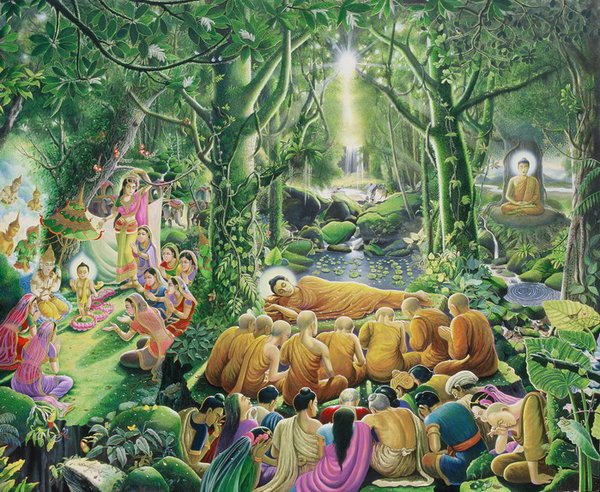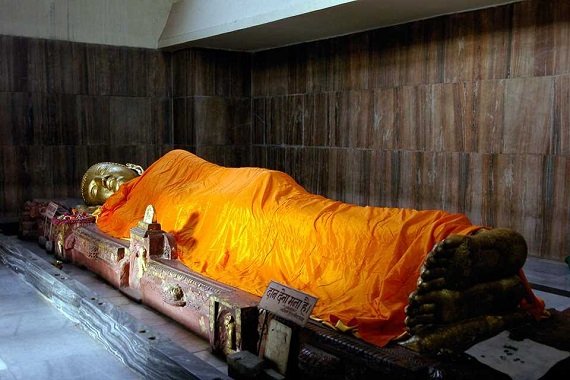
A religious pilgrimage center in the Kushinagar district of the beautiful state of Uttar Pradesh, Kushinagar is a place where Lord Buddha attained Nirvana. It is famous for many monasteries and stupas from years ago are now almost in ruins. Every year many devotees from all over the world visit this place to find out what the city has to offer to its guests. You can also visit many temples during your visit to Kushinagar for good experiences. The most explored site of this beautiful city is the Mahaparinirvana Stupa which stands above the spot where Gautama Buddha is finally resting. So plan your trip to this beautiful place and enjoy your idyllic retreat.
The history of Kushinagar dates back centuries and at that time it was known as Kushavati (Jataka). It is mentioned in the Ramayana and it is said that the city got its name from Kush, the son of Lord Rama. In addition, it was a famous place of the Malla kingdom of ancient India. According to legends, Gautam Buddha fell ill after eating some mushrooms served by a local. And once he was cured of his illness, he attained final Nirvana at this place. Many of the stupas here were constructed centuries ago and Ashoka of the Maurya Empire is said to have contributed significantly to the construction at this place. Legend has it that it was an important site for Jain, Vaishnavism and Shaivism values.
In Buddhism, it is believed that vast spiritual energy remains where Buddha or other sacred beings lived, or where great mahasiddhas (Sanskrit: mahasiddha ‘great accomplished’) performed enlightening works. The pilgrim receives powerful blessings only by his presence at these places as the divine energy of the universe plants the spiritual seed in the stream of mind and opens up the qualities of past lives.

Many practicing Buddhists recognize these qualities and their importance. They travel to holy sites infused with sacred energy to seek blessings and create reasons to meet future Buddhas and receive their teachings.
Buddha Shakyamuni himself recommended the holy pilgrimage for future practitioners. Before going into Mahaparinirvana (Sanskrit: Mahaparinirvana; final nirvana after death), he advised the holy disciples to visit four places for inspiration after his departure:
Lumbini, where Lord Buddha was born;
Bodh Gaya, where he attained supreme knowledge;
Deer Park at Sarnath, where he gave his first sermon; And
Kushinara (now known as Kushinagar), where he passed into Mahaparinirvana.
The importance of these sites is further strengthened by Buddhist scriptures that tell us that Buddhas of the past and future will appear here again to perform enlightened deeds.
Who can you meet on a pilgrimage? What can you find? Which way can you open? Here, we explore various sacred sites for pilgrims to visit, connect with the energies of the sacred beings who came before them and harness their potential for enlightenment.
Significance of Kushinagar
Buddha Shakyamuni gave three reasons why he chose Kushinagar (in today’s northern Indian state of Uttar Pradesh) for death:
This was the proper place to teach the Maha-Sudasana Sutra (The Story of the Great King of Glory).
Subhadda, whom Buddha Shakyamuni still felt the need to teach, was present there. As a result Subhadda Buddha became the last monk to be ordained by Shakyamuni; Meditating on the teachings received directly from the Buddha, he rapidly became an arhat (perfect) and entered parinirvana shortly before Buddha Shakyamuni.

Buddha Shakyamuni predicted that his disciples would argue over sharing his relics. He wanted a wise and respected old Brahmin of Kushinagar to mediate in the disagreement of the Doha disciples.
Buddha Shakyamuni died in Kushinagar
According to scriptures, Buddha Shakyamuni mentioned his ability to live to the end of the kalpa three times to his 20-year-old disciple Ananda. When Ananda failed to understand the importance of his words, Buddha Shakyamuni decided not to prolong his life.
Although Ananda immediately appealed to Buddha Shakyamuni to live long enough to understand the implications of his words, Ananda’s request came too late. After about 45 years of teaching at Kushinagar on the banks of the Hiranyavati River, Buddha Shakyamuni felt that he was nearing the end of his life. While comforting Ananda, the Buddha said,
“Do not grieve, joy!
The nature of things dictates that we should leave our dear ones. Everything that is born has its own end. I too, Anand, have grown old and full over the years. My journey is drawing to a close; I am turning 80 and just as a worn out car can only be made to move with a great deal of care, so can the Buddha’s body be handled only with extra care”.
Then the Buddha asked Ananda to prepare a bed among the 2-year-old trees with the head facing north and he lay down in it. When the third watch of the night came to a close, Buddha Shakyamuni asked his disciples three times if they had any doubts about the teachings or subjects. All the monks (devotees) remained silent. Buddha Shakyamuni then spoke his last words:
“Not one, doubts Anand.
In the end everyone will get knowledge. Immortality is inherent in all things. Work your freedom with diligence.”
Then, going through the absorption of meditation, Buddha Shakyamuni entered Mahaparinirvana. It is said that the earth shook, the stars fell from the sky, the sky burst into flames in ten directions and the air was filled with celestial music.
Upon his death, Buddha Shakyamuni’s body was bathed and then once again clothed and wrapped in a thousand shrouds before being placed in a coffin of precious substances. After seven days, during which time offerings were made by gods and men, the coffin was carried in a large procession to the place of cremation and placed on a pyre of scented wood and aromatic oils.
Kushinagar Buddha Funeral
However, several attempts to burn the pyre failed. This is because Buddha Shakyamuni’s great disciple, Mahakashyapa had not yet paid his respects and was making his way to pay homage to the body of Buddha Shakyamuni, along with 500 students. After Mahakashyap arrived, prostrated and paid tribute, the pyre automatically engulfed in flames.
After the cremation only a skull bone, teeth and inner and outer shrouds remained. As predicted by Buddha Shakyamuni, there was controversy over the distribution of the relics. The Mallas kingdom within which Kushinagara lay claimed all the remains of Buddha Shakyamuni’s body, but met with competing claims from representatives of the other seven kingdoms that constituted ancient India.
The Brahmin couplet suggests an equal, eight-fold division of the relics between them, assuming his role as Buddha Shakyamuni’s designated mediator. This was accepted by the states; Each took his share and eight great stupas were built over him all over India.
Over time, these relics were redistributed after King Ashoka decided to build 84,000 stupas. Today, they are contained in various stupas spread across Asia.
With its rich history and the importance of the existence of Buddha, Kushinagar is today one of the favorite places for Buddhists to go on pilgrimage and is home to many attractions.
Main holy places of Kushinagar
Being a witness to an important event like the demise of Buddha Shakyamuni, Kushinagar has become home to many sites of religious importance. Here is a brief guide to the three major pilgrimage sites.
Mahaparnirvana Temple
Mahaparinirvana Temple is located in Kasia village of new Deoria district. The temple complex consists of a main building with a unique curved roof structure that houses a large 5th-century statue of Buddha Shakyamuni and an inscribed stupa next to which the temple is built. Both structures are painted a brilliant pure white.
Inside the temple is a statue of Buddha Shakyamuni which depicts him lying on a bed, with the now famous posture of Buddha lying on his right side facing west. The statue is 20 feet (6.1 m) tall and is made of Chunar sandstone.
Leaning Buddha in Mahaparinirvana Temple
It was excavated in 1876 and rebuilt as a living temple in 1927 by Chandra Swami, a Burmese monk.
Behind the temple is a 62-foot (19 m) white stupa excavated in 1867, known as the Parinirvana Stupa. It houses the relics of Buddha Shakyamuni.
Rambhar Stupa
Rambhar Stupa is another stupa of great importance in Kushinagar. This is where Buddha Shakyamuni was cremated, just 1.5 km east of the Mahaparinirvana Temple. This stupa is 49 feet (14.9 m) high and is often referred to as Mukut-Bandhan Vihara (Garden of the Bound Crown) in ancient Buddhist texts.
Math Kur Shrine
The third holy site of great importance is the Matha Kur Tirtha, which literally means ‘prostration to the forehead’.
Math Kuar Shrine from Sommer (2015)
Within the building is a 10-foot (3.05 m) Buddha statue. The idol is a symbol of Buddha Shakyamuni meditating under the Bodhi tree in Bhumisparsha mudra (earth-touching pose) and is carved out of blue stone.
Other Important places to visit in kushinagar
Wat Thai Temple Kushinagar
Indo-Japan Sri Lanka Temple: The famous eight metal statue of Gautam Buddha, which was transported from Japan, the Indo-Japan Sri Lanka Temple is a highly visited attraction in a beautiful town of Kushinagar. The architectural genius was built by the Atago Isshin World Buddhist Cultural Association.
Chinese Temple: Also known as Lin Sun Temple, the Chinese Temple is different from other temples located in Kushinagar. It is a mix of Vietnamese and Chinese structural design. Not only this, the temple has a majestic statue of Lord Buddha which attracts tourists from all over the world.
Wat Thai Temple: One of the major sacred places for Buddhist followers, Wat Thai Temple attracts travelers with its splendid architectural beauty. It is surrounded by different types of trees and vegetation.
Meditation Park: A small park located near the Mahaparinirvana Temple in Kushinagar, the Meditation Park has water bodies with bright green beauty making it an ideal place for meditation. Travelers come to this park to relax in the peaceful and calm atmosphere.

